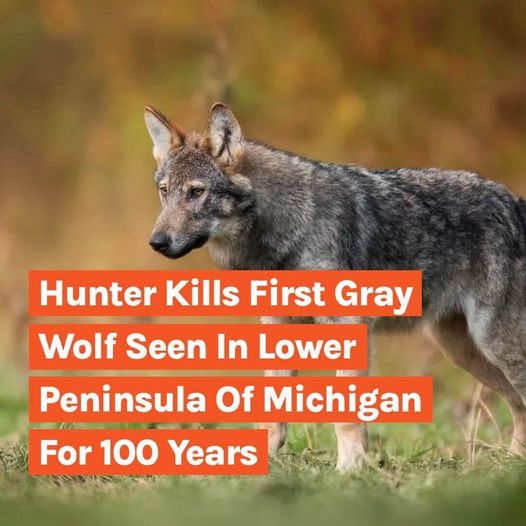Gray wolves have not appeared in the Lower Peninsula of Michigan for almost a hundred years. So during a legal hunt, a hunter shot a creature, thinking it was a coyote. But upon further inspection, as well as confirmation from the Michigan Department of Natural Resources, the coyote was actually a gray wolf, and authorities still don’t know how it got there.
Where Did the Gray Wolf Come From?

Gray wolves used to live throughout Michigan in the 1800s but culls and logging greatly reduced their population until they became endangered. Small packs remained in the Upper Peninsula but none have been seen in the Lower Peninsula since the beginning of the 1900s.
Unfortunately, the Michigan Department of Natural Resources doesn’t believe this wolf is indicative of a new generation of local gray wolves. However, they have yet to understand why this individual was in the area. But wolves can wander across large distances, so it’s probable it was hunting for food or a mate and ventured too far from home.
“This is an unusual case, and the [Department of Natural Resources] is actively delving into the matter to learn more about this particular animal’s origin,” Brian Roell, large carnivore specialist for the DNR, said in a statement. “While rare, instances of wolves traversing vast distances have been documented, including signs of wolves in recent decades in Michigan’s Lower Peninsula.” He believes the wolf’s appearance was “just a one-off kind of thing.”
No Charges

In general, gray wolves are protected under the Endangered Species Act and can only be killed if they are directly threatening human life. Despite this not being the case, the hunter responsible for the kill as well as the guide of the hunt received no charges.
“The conduct here appears to be based on a reasonable and honest belief they were legally shooting a coyote,” said Calhoun County prosecutor David Gilbert. By the time of the investigation, the wolf had already been taxidermied so the DNR had seized it. Because the animal is endangered, the hunter is not permitted to keep the mount.
“This is an unusual case, and the DNR is actively delving into the matter to learn more about this particular animal’s origin,” Roell said. The organization is asking the public for information on how the wolf could have appeared in the Lower Peninsula.
Wolves or Coyotes

For casual observers, it’s easy to confuse coyotes and wolves since they share similar canine features. However, wolves are much larger with wider builds. The recently killed wolf weighed a whopping 84 pounds while coyotes usually weigh between 25 to 40 pounds. They also tend to have smaller paws, narrower snouts, and pointier ears.
It’s also easy to tell the difference based on their location. Coyotes are more widespread and can better adapt to new habitats, making them more likely to appear in human-occupied areas. Meanwhile, wolves tend to avoid people, and they have overall smaller populations. So if you encounter a wolfish creature close to home, it may be safe to assume it’s a coyote — unless you are this hunter from Michigan.
More About Gray Wolves

Despite the idioms about lone wolves, they actually live and hunt in packs of about six to ten individuals. They have long legs suited for running fast and long distances, as well as keen eyes, ears, and noses. These senses are vital because their prey includes medium and large-hooved mammals like moose, bison, deer, and elk. They also eat smaller prey like hares and rodents. Despite popular belief, wolves don’t howl at the moon; they howl to communicate to their pack and to warn other packs to stay away.
An Endangered Species

After being severely overhunted, their numbers are slowly recovering. Wolves play a critical role in their ecosystem that benefits many species including beavers, foxes, and songbirds. They can thrive in a wide range of habitats including deserts, tundra, grasslands, woodlands, and forests. Every animal is a player on the stage that is their environment, and as a predator, wolves have a starring role.
